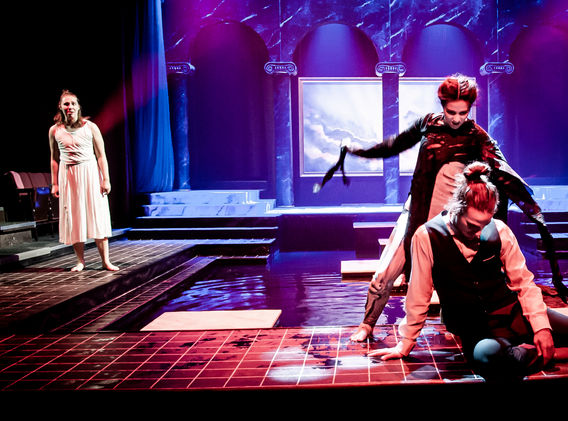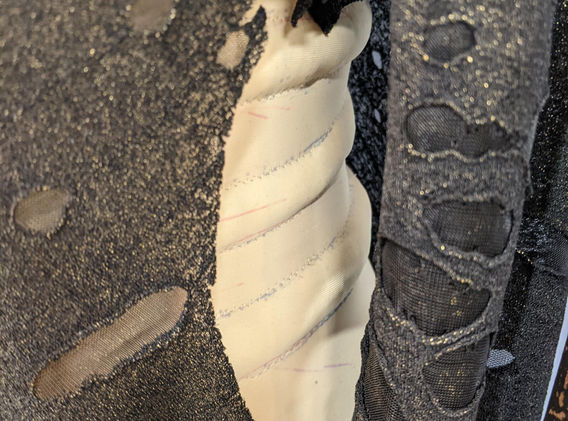Metamorphoses
Ceyx
For this look, the costume designer, Maddy Simpson, and I had to work together on how to make the circle cape also become wings. The original fabric that was bought for the chiton was severely shrunk in the dyeing process. The designer and her mentor went out and bought crepe back stain and we decided to use the non-shiny side of the fabric. The circle cape needed to be able to wrap around the torso and then hook to the back of chiton. I accomplished this by sewing down the under lap of cape at the shoulder and then having a snap on the back of the other shoulder for the overlap of the cape.
Iris
I worked on Iris and Hunger in tandem at the beginning. They both started with the same base. I created the pattern by using the "Quick and Dirty Unitard Pattern." Using the same pattern for both, I was able to have one first fitting for both costumes. Iris's costume consisted of two parts: a base unitard with LED lights sewn in and an overdress. I created the base unitard and then handed the costume off to crafts for the lights to be sewn in. I then created the overdress by gathering the each of the two drops of fabric on to a neck band. I then put side tabs to connect the front and back to the overdress. To finish off the overdress, I sewed parts of a necklace on top.
Hunger
After finishing the first fitting with the mock up unitard, Hunger's costume departed from Iris's. Hunger costumes consisted of three parts: a unitard with trapunto quilting details, an dress sewn to the unitard, and a 14' long cape. To create the bone detail, the unitard has two layers of spandex flat lined together. Then, once the placement of the bones is figured out, the shape was stitched through both layers. Finally a small hole is cut in the inner layer of spandex and stuffed. It creates a lovely 3D detail in the unitards.
After that, the over dress was draped on the stand. Once it is in place, I stitched the dress to the unitard and itself. In another fitting, I had the costume designer cut and destress the hem to her linking.
The last piece of the look was a very long cape to trail behind the character when they entered. I had not created a cape than needed to be so long before. I thought I could approach it like a costume, but Laura Robinson, my mentor, told me that I needed to make it like a theatrical drape. Stitching together drops of fabric and then making the shape of the cape was the advise I was given. It worked perfectly and I will definitely be using that method in future endeavors.


































